New Approaches to Friction Stir Welding of Aluminum Light-Alloys
Abstract
:1. Introduction
1.1. Background
1.2. FSW Process Peculiarities
- Nugget zone (NZ): This is where the metal is in direct contact with the pin being continuously stirred during the passage of the rotating pin, thus creating the necessary strong bond between the two metals under the welding. Fast thermomechanical heating and cooling occur, and they favour the occurrence of recrystallization phenomena. Thence, fine grain structures in the form of onion rings are generally formed.
- Thermomechanically affected zone (TMAZ): Where the microstructure is highly plastically deformed. In this zone the microstructure experiences a significant grain morphology and size modification with occurrence of secondary phase particles precipitation or coarsening, in the cases of age-hardening aluminum and magnesium alloys. Although the TMAZ undergoes plastic deformation, recrystallization does not occur in this zone due to insufficient deformation strain.
- Heat affected zone (HAZ): Where the material undergoes thermal cycles with no plastic deformation. In this zone the microstructure is characterized by retaining same grain structures as the parent material.
1.3. Outlines of FSW Applied to Aluminum Alloys
1.4. Typical Microstructure of FSW Joints
2. New Approaches to the FSW Joining Techniques for Light Alloys
2.1. Experimental Setup
2.2. Double Side Friction Stir Welding Methodology
2.3. RT-Type Friction Stir Welding Approach
3. Results and Discussion
4. Conclusions
- Double side FSW (DS-FSW): (i) Elastic modulus, limiting dome height (LDH) and the local hardness showed a significant uniformity across the sheet section with respect to conventional FSW; (ii) homogeneous fine recrystallized (RX) grains were formed across the NZ, while in conventional FSW, coarser RX grains were observed; (iii) the microstructural and mechanical homogeneities generated a better formability (LDH) of the DS-FSW AA6082 sheet, compared to the conventional FSW. This interesting result held for pin and pinless welding processes.
- Pin deviation form centreline (RT): (i) The best RT FSW settings were found for a pin deviation from centreline by 1/30 (0.5 mm) of the shoulder diameter, using a truncated conical shaped pin with heights of 2.0 and 2.3 mm in a 2.5 thick AA5754 sheet. With these FSW set-ups, the post-welded annealed sheet showed the most significant mechanical improvements, among the different experimental conditions tested, over the conventional FSW technique; (ii) the induced microstructural modifications across the NZ, TMAZ and the HAZ were driven by geometric dynamic recrystallization (DRX) mechanism. This was ultimately induced by the combined effect of the shoulder pressure (heat input), and the post-welding annealing thermal energy.
- FSW emerged as an advanced technique for the joining of similar/dissimilar metals and alloys to be potentially adopted in various manufacturing and engineering application fields, such oil and gas pipelines, automobile part joining and aviation joining. The latest new approaches well addressed and accounted for FSW’s widening potential to include new metal processing applications, wider light alloy candidates and new metallurgical production techniques, such as the additive manufacturing (AM). In this respect, the two herein presented new approaches showed a clear mechanical improvement of FSW joints in the case of aluminum alloy sheets, both non-age-hardening and age-hardening. New FSW approaches and methods, such the ones presented, make this joining technique one of the most prominent and promising welding techniques to foster and promote new technology frontiers in the making and repairing processing of light metal sheets and plates. Indeed, recent metallurgical developments, namely, additive manufacturing (AM), showed the applicability of the FSW to complex parts and components, promoting the adoption of this technique to a manufacturing scale. In this regard, the combination of friction stir processing (FSP) with other derived friction non-melting strengthening methods, can be nowadays considered as a direct evolution step of the FSW from which it originated, able to scale up all the possible application fields of this non-fusion metal attrition technique.
Author Contributions
Funding
Conflicts of Interest
References
- Simar, A.; Bréchet, Y.; De Meester, B.; Denquin, A.; Gallais, C.; Pardoen, T. Integrated modeling of friction stir welding of 6xxx series Al alloys: Process, microstructure and properties. Prog. Mater. Sci. 2012, 57, 95–183. [Google Scholar] [CrossRef] [Green Version]
- Braga, D.F.O.; Tavares, S.M.O.; Da Silva, L.F.M.; Moreira, P.M.G.P.; De Castro, P.M.S.T. Advanced design for lightweight structures: Review and prospects. Prog. Aerosp. Sci. 2014, 69, 29–39. [Google Scholar] [CrossRef]
- Węglowski, M.S. Friction stir processing–State of the art. Arch. Civ. Mech. Eng. 2018, 18, 114–129. [Google Scholar] [CrossRef]
- Haghshenas, M.; Gerlich, A.P. Joining of automotive sheet materials by friction-based welding methods: A review. Eng. Sci. Technol. Int. J. 2018, 21, 130–148. [Google Scholar] [CrossRef]
- Singh, K.; Singh, G.; Singh, H. Review on friction stir welding of magnesium alloys. J. Magnes. Alloy. 2018, 6, 399–416. [Google Scholar] [CrossRef]
- Shinde, G.; Gajghate, S.; Dabeer, P.S.; Seemikeri, C.Y. Low Cost Friction Stir Welding: A Review. Mater. Today Proc. 2017, 4, 8901–8910. [Google Scholar] [CrossRef]
- Mishra, R.S.; Ma, Z.Y. Friction stir welding and processing. Mater. Sci. Eng. R Rep. 2005, 50, 1–78. [Google Scholar] [CrossRef]
- Gangwar, K.; Ramulu, M. Friction stir welding of titanium alloys: A review. Mater. Des. 2018, 141, 230–255. [Google Scholar] [CrossRef]
- Wang, G.; Zhao, Y.; Hao, Y. Friction stir welding of high-strength aerospace aluminum alloy and application in rocket tank manufacturing. J. Mater. Sci. Technol. 2018, 34, 73–91. [Google Scholar] [CrossRef]
- Mohanty, H.; Mahapatra, M.; Kumar, P.; Jha, P. Modeling the effects of tool geometries on the temperature distributions and material flow of friction stirred AA7039 weld. Model. Simul. Mater. 2013, 25–32. [Google Scholar]
- Thomas, W.M.; Nicholas, E.D.; Needham, J.C.; Murch, M.; Templesmith, G.P.; Dawes, C.J. Friction Stir Butt Welding. U.S. Patent 5460317, 1995. [Google Scholar]
- Dawes, C.J.; Thomas, W.M. Friction stir process welds aluminum alloys. The process produces low-distortion, high-quality, low-cost welds on aluminum. Weld. J. (Miami FL) 1996, 75, 41–45. [Google Scholar]
- Nicholas, E.D.; Thomas, W.M. A review of friction processes for aerospace applications. Int. J. Mater. Prod. Technol. 1998, 13, 45–55. [Google Scholar]
- Thomas, W.M.; Johnson, K.I.; Wiesner, C.S. Friction stir welding-recent developments in tool and process technologies. Adv. Eng. Mater. 2003, 5, 485–490. [Google Scholar] [CrossRef]
- Rai, R.; De, A.; Bhadeshia, H.K.D.H.; DebRoy, T. Review: Friction stir welding tools. Sci. Technol. Weld. Join. 2011, 16, 325–342. [Google Scholar] [CrossRef]
- Cabibbo, M.; Forcellese, A.; El Mehtedi, M.; Simoncini, M. Double side friction stir welding of AA6082 sheets: Microstructure and nanoindentation characterization. Mater. Sci. Eng. A 2014, 590, 209–217. [Google Scholar] [CrossRef]
- Simoncini, M.; Cabibbo, M.; Forcellese, A. Development of double-side friction stir welding to improve post-welding formability of joints in AA6082 aluminium alloy. Proc. Inst. Mech. Eng. Part B J. Eng. Manuf. 2016, 230, 807–817. [Google Scholar] [CrossRef]
- Cabibbo, M.; Forcellese, A.; Simoncini, M.; Pieralisi, M.; Ciccarelli, D. Effect of welding motion and pre-/post-annealing of friction stir welded AA5754 joints. Mater. Des. 2016, 93, 146–159. [Google Scholar] [CrossRef]
- Cerri, E.; Renna, G.; Cabibbo, M.; Simoncini, M.; Forcellese, A. Friction stir processing at high rotation rates of a magnesium alloy: Mechanical properties at high temperatures and microstructure. Mater. Sci. Forum 2017, 879, 295–300. [Google Scholar] [CrossRef]
- Mehta, M.; Arora, A.; Debroy, T. Tool geometry for friction stir welding—Optimum shoulder diameter. Metall. Mater. Trans. A 2011, 42, 2716–2722. [Google Scholar] [CrossRef]
- Su, H.; Wu, C.S.; Bachmann, M.; Rethmeier, M. Numerical modeling for the effect of pin profiles on thermal and material flow characteristics in friction stir welding. Mater. Des. 2015, 77, 114–125. [Google Scholar] [CrossRef]
- Bevilacqua, M.; Ciarapica, F.E.; D’Orazio, A.; Forcellese, A.; Simoncini, M. Sustainability Analysis of friction stir welding of AA5754 sheets. Procedia CIRP 2017, 62, 529–534. [Google Scholar] [CrossRef]
- Boz, M.; Kurt, A. The influence of stirrer geometry on bonding and mechanical properties in friction stir welding process. Mater. Des. 2004, 25, 343–347. [Google Scholar] [CrossRef]
- Sudhagar, S.; Sakthivel, M.; Mathew, P.J.; Daniel, S.A.A. A multi criteria decision making approach for process improvement in friction stir welding of aluminium alloy. Meas. J. Int. Meas. Confed. 2017, 108, 1–8. [Google Scholar] [CrossRef]
- Bevilacqua, M.; Ciarapica, F.E.; Forcellese, A.; Simoncini, M. Comparison among the environmental impact of solid state and fusion welding processes in joining an aluminium alloy. Proc. Inst. Mech. Eng. Part B J. Eng. Manuf. 2019, 234, 140–156. [Google Scholar] [CrossRef]
- Cabibbo, M.; Forcellese, A.; Simoncini, M. New Approaches to the Friction Stir Welding of Aluminum Alloys. In Joining Technologies; InTech: Rijeka, Croatia, 2016; Chapter 2. [Google Scholar] [CrossRef] [Green Version]
- Niu, P.; Li, W.; Zhang, Z.; Yang, X. Global and local constitutive behaviors of friction stir welded AA2024 joints. J. Mater. Sci. Technol. 2017, 33, 987–990. [Google Scholar] [CrossRef]
- Reimann, M.; Goebel, J.; dos Santos, J.F. Microstructure and mechanical properties of keyhole repair welds in AA 7075-T651 using refill friction stir spot welding. Mater. Des. 2017, 27, 5220–5227. [Google Scholar] [CrossRef]
- Garg, A.; Bhattacharya, A. Strength and failure analysis of similar and dissimilar friction stir spot welds: Influence of different tools and pin geometries. Mater. Des. 2017, 127, 272–286. [Google Scholar] [CrossRef]
- Piccini, J.M.; Svoboda, H.G. Tool geometry optimization in friction stir spot welding of Al-steel joints. J. Manuf. Process. 2017, 26, 142–154. [Google Scholar] [CrossRef]
- Fujii, H.; Cui, L.; Maeda, M.; Nogi, K. Effect of tool shape on mechanical properties and microstructure of friction stir welded aluminum alloys. Mater. Sci. Eng. A 2006, 419, 25–31. [Google Scholar] [CrossRef]
- Wei, S.; Hao, C.; Chen, J. Study of friction stir welding of 01420 aluminum-lithium alloy. Mater. Sci. Eng. A 2007, 452–453, 170–177. [Google Scholar] [CrossRef]
- Patil, H.; Soman, S. Experimental study on the effect of welding speed and tool pin profiles on AA6082-O aluminium friction stir welded butt joints. Int. J. Eng. Sci. Technol. 2010, 2, 268–275. [Google Scholar] [CrossRef]
- Elangovan, K.; Balasubramanian, V.; Valliappan, M. Influences of tool pin profile and axial force on the formation of friction stir processing zone in AA6061 aluminium alloy. Int. J. Adv. Manuf. Technol. 2008, 38, 285–295. [Google Scholar] [CrossRef]
- Liu, H.J.; Zhang, H.J.; Huang, Y.X.; Yu, L. Mechanical properties of underwater friction stir welded 2219 aluminum alloy. Trans. Nonferrous Met. Soc. China Engl. Ed. 2010, 20, 1387–1391. [Google Scholar] [CrossRef]
- Koilraj, M.; Sundareswaran, V.; Vijayan, S.; Koteswara Rao, S.R. Friction stir welding of dissimilar aluminum alloys AA2219 to AA5083 - Optimization of process parameters using Taguchi technique. Mater. Des. 2012, 47, 1–7. [Google Scholar] [CrossRef]
- Tutar, M.; Aydin, H.; Yuce, C.; Yavuz, N.; Bayram, A. The optimisation of process parameters for friction stir spot-welded AA3003-H12 aluminium alloy using a Taguchi orthogonal array. Mater. Des. 2014, 63, 789–797. [Google Scholar] [CrossRef]
- Kumar, A.; Rengaraj, R. Optimization of process parameters of friction stir welding for dissimilar aluminium alloys AA5083-O and 6061-T6. Int. J. Res. Tech. Stud. 2015, 2. 2348–1439. [Google Scholar]
- Kadaganchi, R.; Gankidi, M.R.; Gokhale, H. Optimization of process parameters of aluminum alloy AA 2014-T6 friction stir welds by response surface methodology. Defence Technol. 2015, 11, 209–219. [Google Scholar] [CrossRef] [Green Version]
- Askari, A.; Silling, S.; London, B.; Mahoney, M. Modeling and analysis of friction stir welding processes. Frict. Stir Weld. Process. 2001, 43–54. [Google Scholar] [CrossRef]
- Oh-ishi, K.; Mcnelley, T.R. Microstructural Modification of As-Cast NiAl Bronze. by Friction Stir Processing. Metall. Mater. Trans. A 2004, 35, 2951–2961. [Google Scholar] [CrossRef]
- Sato, Y.S.; Urata, M.; Kokawa, H. Parameters Controlling Microstructure and Hardness during Friction-Stir Welding of Precipitation-Hardenable Aluminum Alloy 6063. Metall. Materials Trans. A 2002, 33, 625–635. [Google Scholar] [CrossRef]
- Su, J.-Q.; Nelson, T.W.; Sterling, C.J. A new route to bulk nanocrystalline materials. J. Mater. Res. 2003, 18, 1757–1760. [Google Scholar] [CrossRef]
- Jata, K.V.; Semiatin, S.L. Continuous dynamic recrystallization during friction stir welding of high strength aluminum alloys. Scr. Mater. 2000, 43, 9–14. [Google Scholar] [CrossRef]
- Su, J.Q.; Nelson, T.W.; Mishra, R.; Mahoney, M. Microstructural investigation of friction stir welded 7050-T651 aluminium. Acta Mater. 2003, 51, 713–729. [Google Scholar] [CrossRef]
- Rollett, A.; Humphreys, F.; Rohrer, G.S.; Hatherly, M. Recrystallization and Related Annealing Phenomena, 2nd ed.; Elsevier: Amsterdam, The Netherlands, 2004; ISBN 9780080441641. [Google Scholar]
- Doherty, R.D.; Hughes, D.A.; Humphreys, F.J.; Jonas, J.J.; Juul Jensen, D.; Kassner, M.E.; King, W.E.; McNelley, T.R.; McQueen, H.J.; Rollett, A.D. Current issues in recrystallization: A review. Mater. Sci. Eng. A 1997, 238, 219–274. [Google Scholar] [CrossRef] [Green Version]
- McQueen, H.J.; Blum, W. Dynamic recovery: Sufficient mechanism in the hot deformation of Al (< 99.99). Mater. Sci. Eng. A 2000, 290, 95–107. [Google Scholar]
- Padhy, G.K.; Wu, C.S.; Gao, S. Friction stir based welding and processing technologies-processes, parameters, microstructures and applications: A review. J. Mater. Sci. Technol. 2018, 34, 1–38. [Google Scholar] [CrossRef]
- Prangnell, P.B.; Heason, C.P. Grain structure formation during friction stir welding observed by the ‘stop action technique’. Acta Mater. 2005, 53, 3179–3192. [Google Scholar] [CrossRef]
- Su, J.Q.; Nelson, T.W.; Sterling, C.J. Microstructure evolution during FSW/FSP of high strength aluminum alloys. Mater. Sci. Eng. A 2005, 405, 277–286. [Google Scholar] [CrossRef]
- Fonda, R.W.; Bingert, J.F.; Colligan, K.J. Development of grain structure during friction stir welding. Scr. Mater. 2004, 51, 243–248. [Google Scholar] [CrossRef]
- James, M.N.; Hattingh, D.G.; Lombard, H.; Wedderburn, I.; Bulbring, D.L.H.; Els-Botes, A.; Steuwer, A. Failure mechanisms in friction stir welds. In Woodhead Publishing Series in Welding and Other Joining Technologies; Woodhead Publishing: Amsterdam, The Netherlands, 2010; pp. 164–189. [Google Scholar]
- Forcellese, A.; Martarelli, M.; Simoncini, M. Effect of process parameters on vertical forces and temperatures developed during friction stir welding of magnesium alloys. Int. J. Adv. Manuf. Technol. 2016, 85, 595–604. [Google Scholar] [CrossRef]
- Forcellese, A.; Martarelli, M.; Pandarese, G.; Simoncini, M. Similar and dissimilar FSWed joints in lightweight alloys: Heating distribution assessment and IR thermography monitoring for on-line quality control. Key Eng. Mater. 2013, 554–557, 1055–1064. [Google Scholar] [CrossRef]
- Mao, Y.; Ke, L.; Chen, Y.; Liu, F.; Xing, L. Inhomogeneity of microstructure and mechanical properties in the nugget of friction stir welded thick 7075 aluminum alloy joints. J. Mater. Sci. Technol. 2018, 34, 228–236. [Google Scholar] [CrossRef]
- Casalino, G.; El Mehtedi, M.; Forcellese, A.; Simoncini, M. Effect of cold rolling on the mechanical properties and formability of FSWed sheets in AA5754-H114. Metals 2018, 8, 223. [Google Scholar] [CrossRef] [Green Version]
- Forcellese, A.; Fratini, L.; Gabrielli, F.; Simoncini, M. Formability of friction stir welded AZ31 magnesium alloy sheets. Mater. Sci. Forum 2010, 638–642, 1249–1254. [Google Scholar] [CrossRef]
- Gabrielli, F.; Forcellese, A.; Mehtedi, M.E.; Simoncini, M. Mechanical Properties and Formability of Cold Rolled Friction Stir Welded Sheets in AA5754 for Automotive Applications. Procedia Eng. 2017, 183, 245–250. [Google Scholar] [CrossRef]
- ISO. Metallic Materials-Sheet and Strip-Determination of Forming Limit Curves Part 2: Determination of Forming Limit Curves in Laboratory; ISO12004-2; ISO: Geneva, Switzerland, 2008. [Google Scholar]
- Bist, A.; Saini, J.S.; Sharma, B. A review of tool wear prediction during friction stir welding of aluminium matrix composite. Trans. Nonferrous Met. Soc. China Engl. Ed. 2016, 26, 2003–2018. [Google Scholar] [CrossRef]
- Buchibabu, V.; Reddy, G.M.; De, A. Probing torque, traverse force and tool durability in friction stir welding of aluminum alloys. J. Mater. Process. Technol. 2017, 241, 86–92. [Google Scholar] [CrossRef]
- Bagheri, A.; Azdast, T.; Doniavi, A. An experimental study on mechanical properties of friction stir welded ABS sheets. Mater. Des. 2013, 43, 402–409. [Google Scholar] [CrossRef]
- Colligan, K. Material flow behavior during friction stir welding of aluminum. Weld. J. (Miami FL) 1999, 87, 1115–1123. [Google Scholar]
- Guerra, M.; Schmidt, C.; McClure, J.C.; Murr, L.E.; Nunes, A.C. Flow patterns during friction stir welding. Mater. Charact. 2002, 49, 95–101. [Google Scholar] [CrossRef] [Green Version]
- Fratini, L.; Buffa, G.; Palmeri, D.; Hua, J.; Shivpuri, R. Material flow in FSW of AA7075-T6 butt joints: Numerical simulations and experimental verifications. Sci. Technol. Weld. Join. 2006, 11, 412–421. [Google Scholar] [CrossRef]
- Schmidt, H.N.B.; Dickerson, T.L.; Hattel, J.H. Material flow in butt friction stir welds in AA2024-T3. Acta Mater. 2006, 54, 1199–1209. [Google Scholar] [CrossRef]
- Zhao, Y.H.; Lin, S.B.; Qu, F.X.; Wu, L. Influence of pin geometry on material flow in friction stir welding process. Mater. Sci. Technol. 2006, 22, 45–50. [Google Scholar] [CrossRef]
- Leitão, C.; Leal, R.M.; Rodrigues, D.M.; Vilaça, P.; Loureiro, A. Material flow in Friction Stir Welding. Microsc. Microanal. 2008, 14, 87–90. [Google Scholar] [CrossRef] [Green Version]
- Chen, Z.W.; Pasang, T.; Qi, Y. Shear flow and formation of Nugget zone during friction stir welding of aluminium alloy 5083-O. Mater. Sci. Eng. A 2008, 474, 312–316. [Google Scholar] [CrossRef]
- Fonda, R.; Reynolds, A.; Feng, C.R.; Knipling, K.; Rowenhorst, D. Material Flow in Friction Stir Welds. Microsc. Microanal. 2013, 44, 337–344. [Google Scholar] [CrossRef]
- Leal, R.M.; Leitão, C.; Loureiro, A.; Rodrigues, D.M.; Vilaça, P. Material flow in heterogeneous friction stir welding of thin aluminium sheets: Effect of shoulder geometry. Mater. Sci. Eng. A 2008, 498, 384–391. [Google Scholar] [CrossRef] [Green Version]
- Leitão, C.; Louro, R.; Rodrigues, D.M. Analysis of high temperature plastic behaviour and its relation with weldability in friction stir welding for aluminium alloys AA5083-H111 and AA6082-T6. Mater. Des. 2012, 37, 402–409. [Google Scholar] [CrossRef]
- Kumar, K.; Kailas, S.V. The role of friction stir welding tool on material flow and weld formation. Mater. Sci. Eng. A 2008, 485, 367–374. [Google Scholar] [CrossRef] [Green Version]
- Arbegast, W.J. A flow-partitioned deformation zone model for defect formation during friction stir welding. Scr. Mater. 2008, 58, 372–376. [Google Scholar] [CrossRef] [Green Version]
- Forcellese, A.; Simoncini, M. Plastic flow behaviour and formability of friction stir welded joints in AZ31 thin sheets obtained using the “pinless” tool configuration. Mater. Des. 2012, 36, 123–129. [Google Scholar] [CrossRef]
- Hattingh, D.G.; Blignault, C.; van Niekerk, T.I.; James, M.N. Characterization of the influences of FSW tool geometry on welding forces and weld tensile strength using an instrumented tool. J. Mater. Process. Technol. 2008, 203, 46–57. [Google Scholar] [CrossRef]
- Zhang, Y.N.; Cao, X.; Larose, S.; Wanjara, P. Review of tools for friction stir welding and processing. Can. Metall. Q. 2012, 51, 250–261. [Google Scholar] [CrossRef]


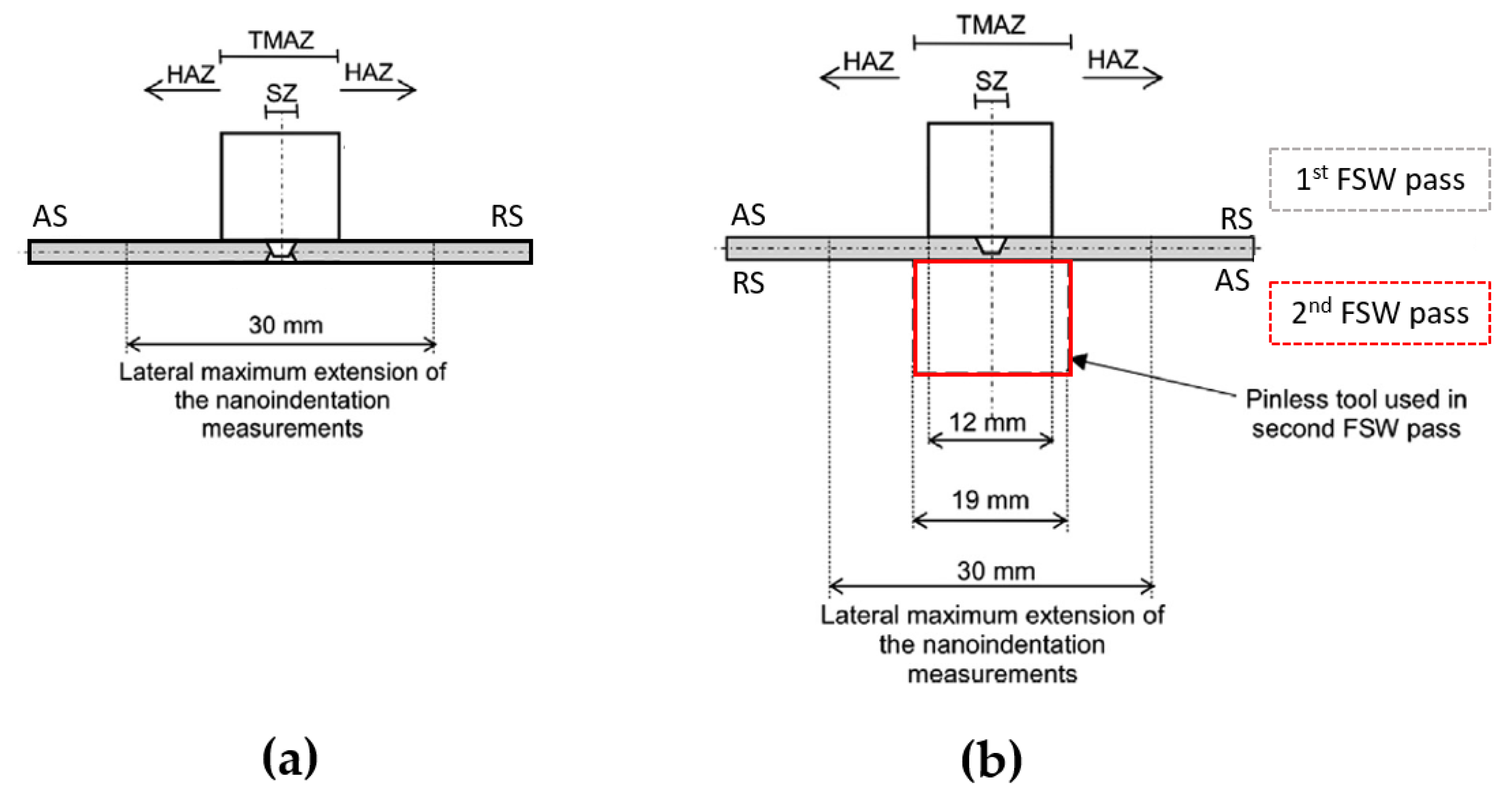
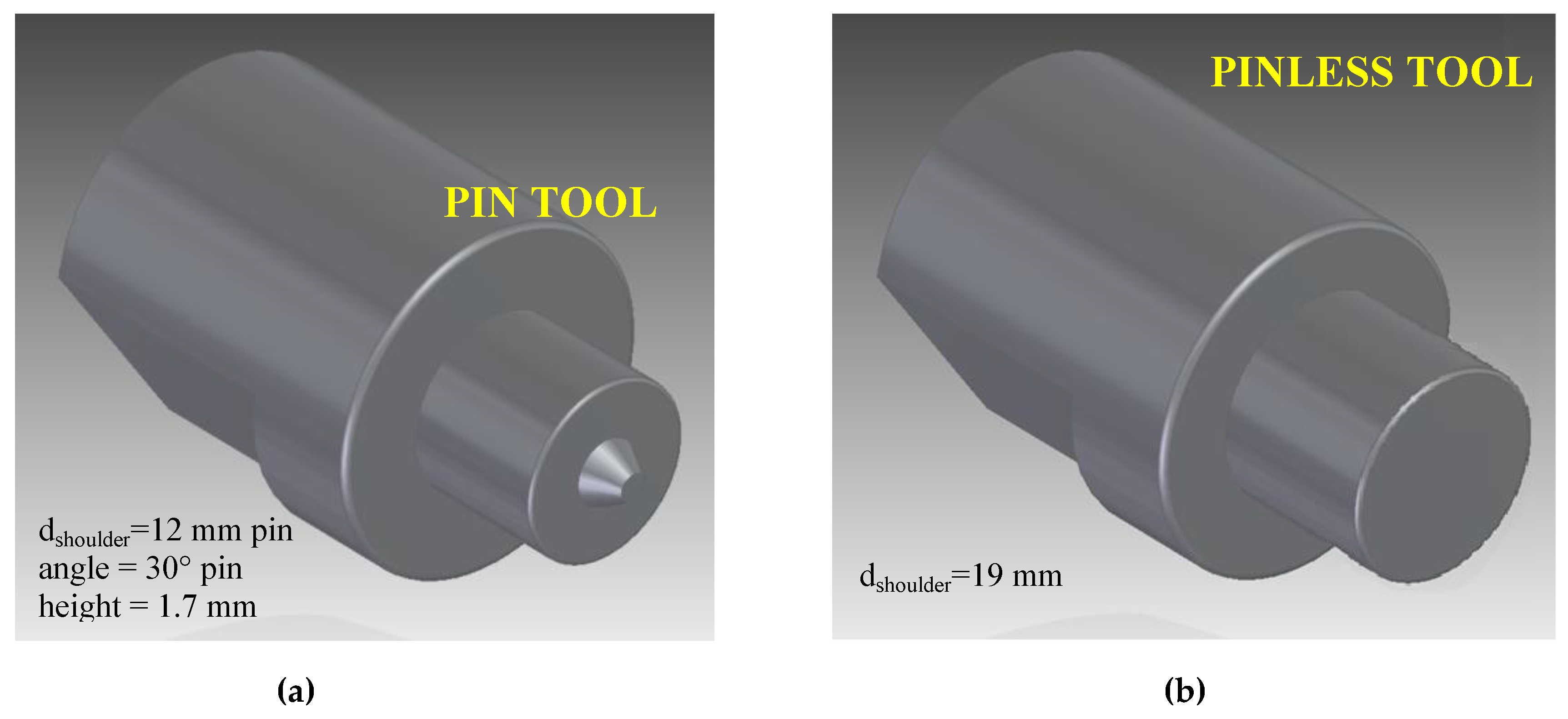
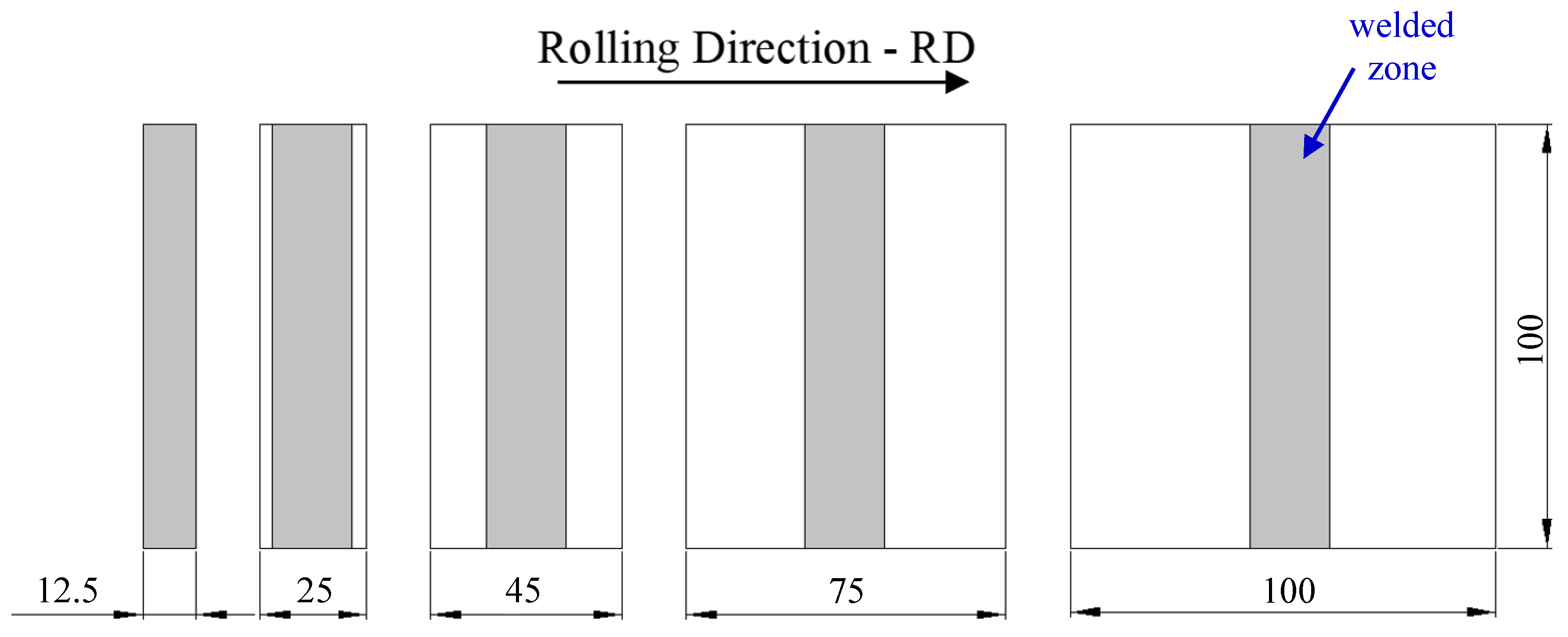


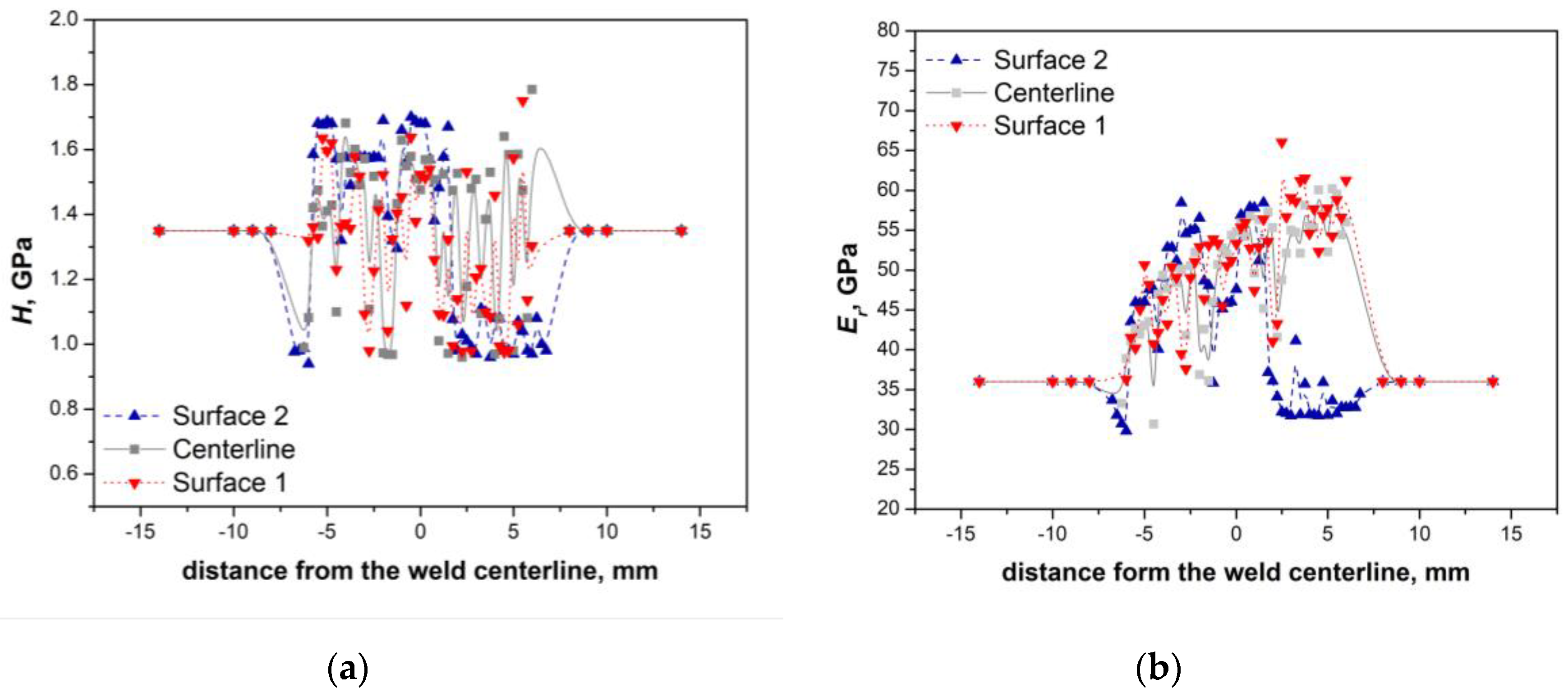
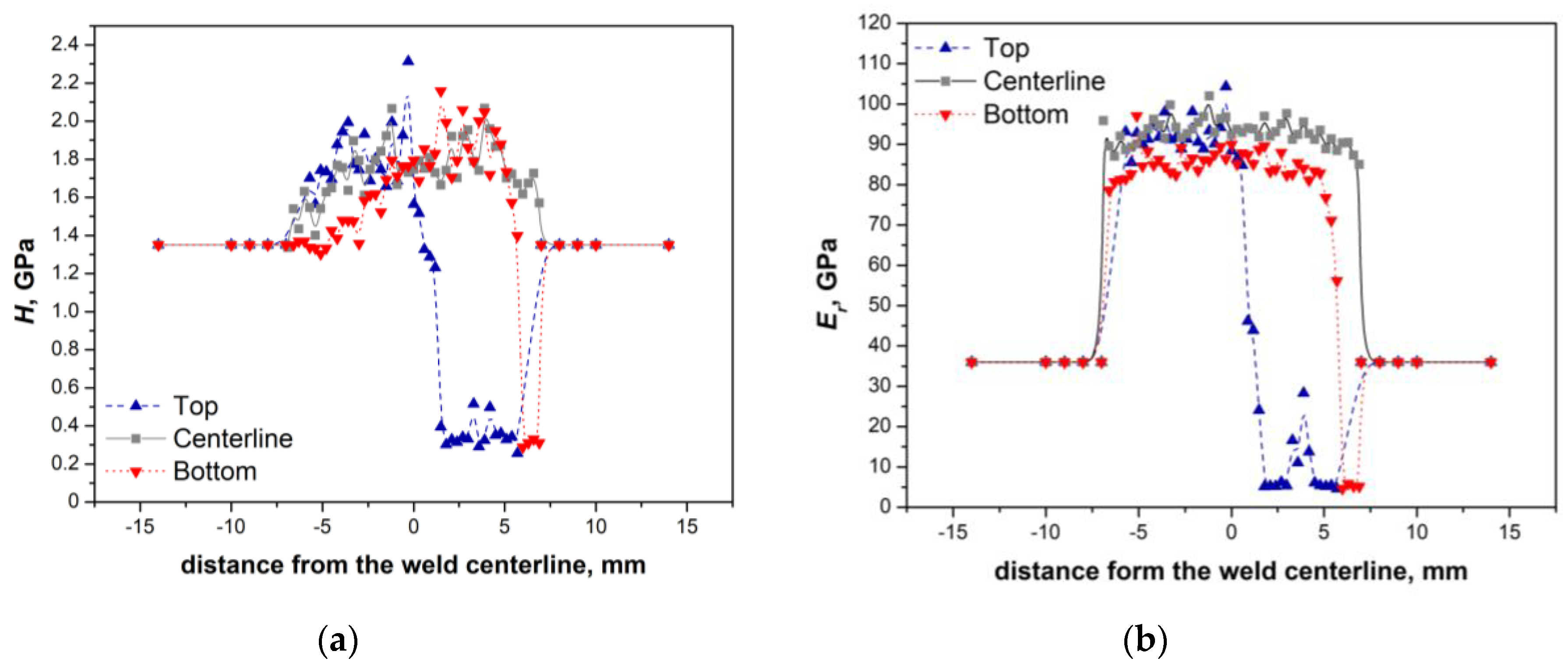

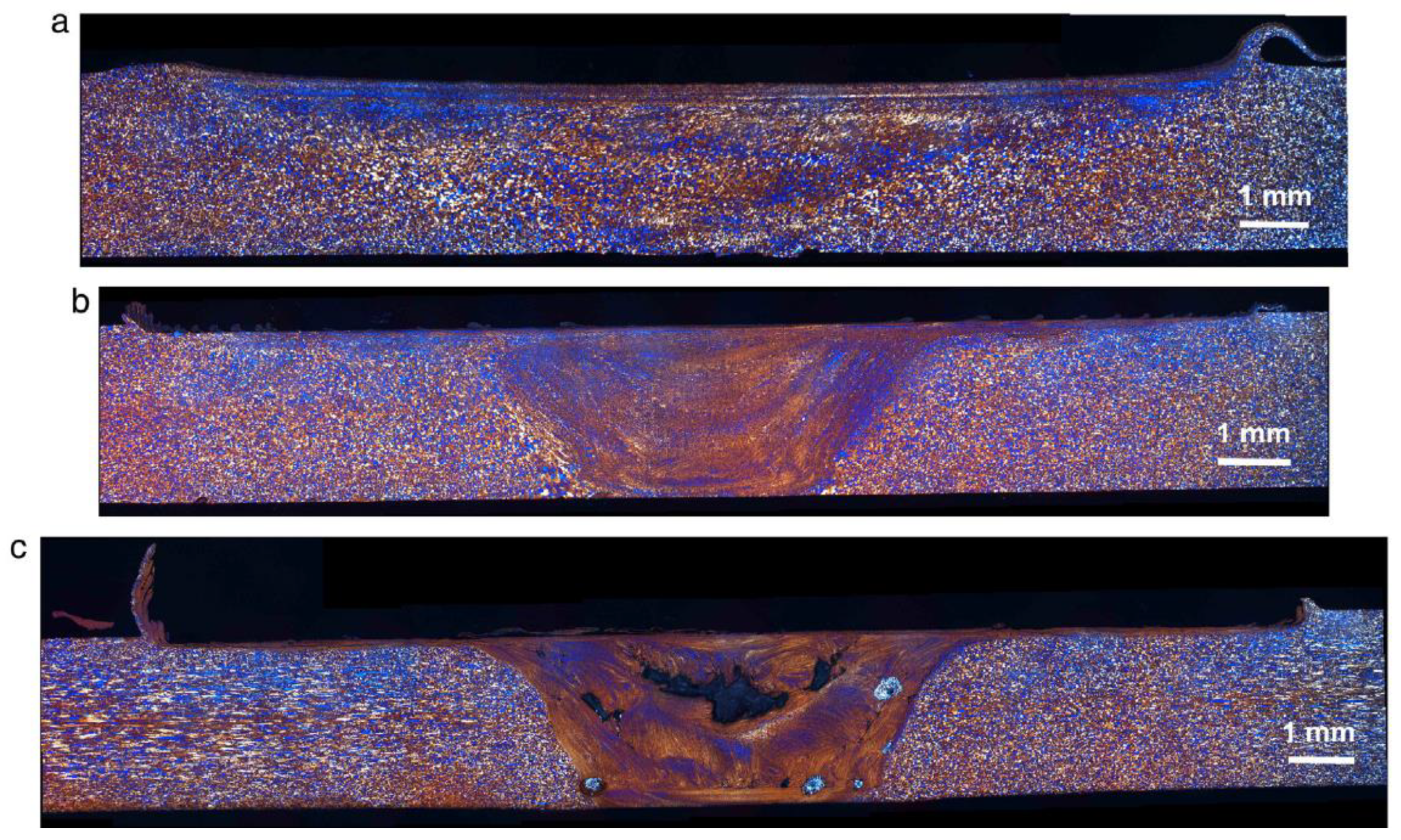
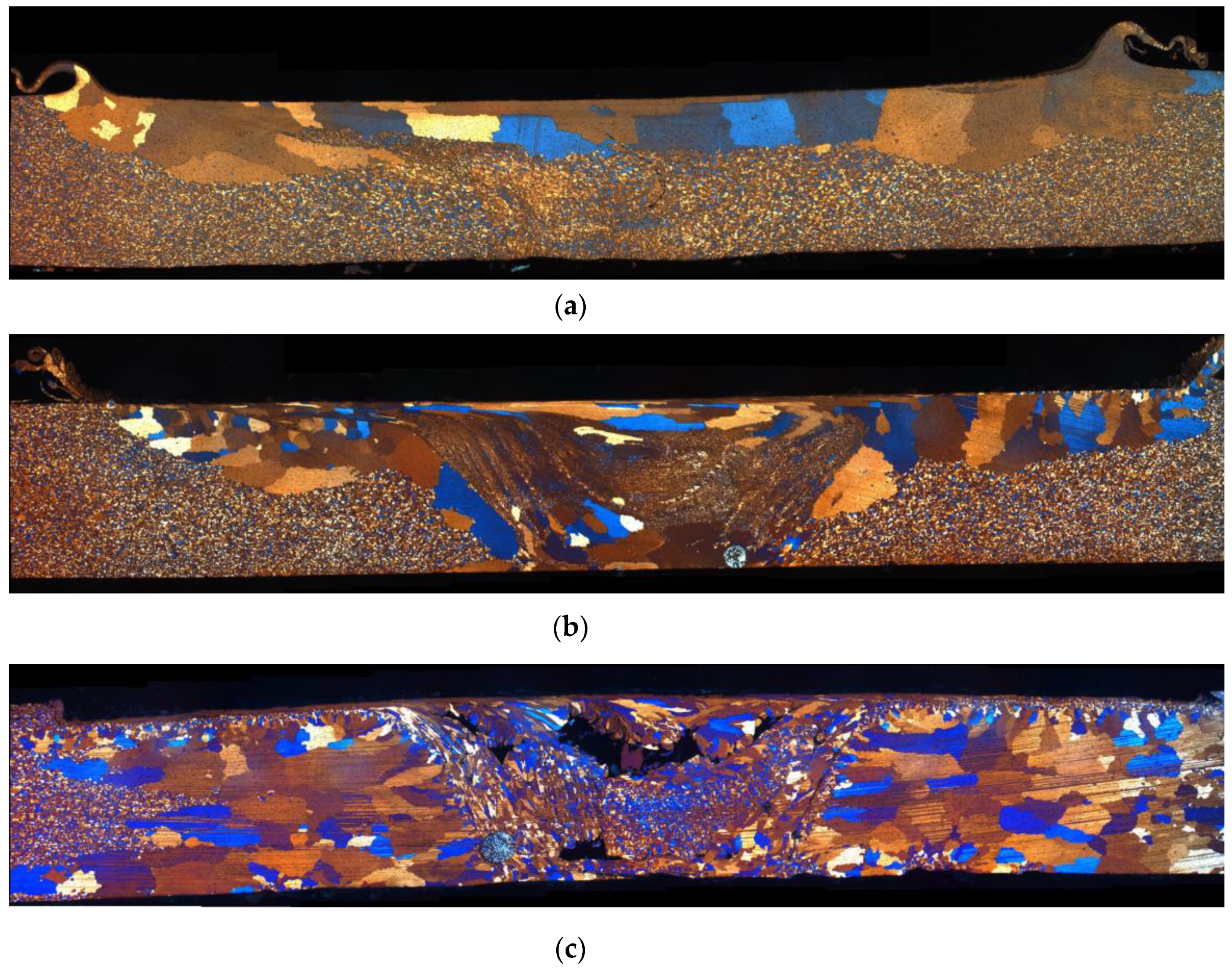
| Plate Condition | LDH (mm) | Reduction in LDH with Respect BM (%) |
|---|---|---|
| BM | 11.9 | - |
| FSW | 8.6 | 27.73 |
| DS-FSW | 10.6 | 10.92 |
| Mechanical Properties | Un-Welded Material | Conventional FSW R = 0 mm | Innovative RT-Type FSW | |||||
|---|---|---|---|---|---|---|---|---|
| R = 0.5 mm | R = 1 mm | |||||||
| as Received | Annealed | as Received | PWA | as Received | PWA | as Received | PWA | |
| UTS (MPa) | 260 ± 10 | 230 ± 10 | 230 ± 10 | 130 ± 10 | 190 ± 10 | 240 ± 10 | defects | 220 ± 10 |
| UE (%) | 23 ± 1 | 37 ± 1 | 18 ± 1 | 3 ± 0.5 | 5 ± 0.5 | 26 ± 0.5 | defects | 18 ± 1 |
© 2020 by the authors. Licensee MDPI, Basel, Switzerland. This article is an open access article distributed under the terms and conditions of the Creative Commons Attribution (CC BY) license (http://creativecommons.org/licenses/by/4.0/).
Share and Cite
Cabibbo, M.; Forcellese, A.; Santecchia, E.; Paoletti, C.; Spigarelli, S.; Simoncini, M. New Approaches to Friction Stir Welding of Aluminum Light-Alloys. Metals 2020, 10, 233. https://doi.org/10.3390/met10020233
Cabibbo M, Forcellese A, Santecchia E, Paoletti C, Spigarelli S, Simoncini M. New Approaches to Friction Stir Welding of Aluminum Light-Alloys. Metals. 2020; 10(2):233. https://doi.org/10.3390/met10020233
Chicago/Turabian StyleCabibbo, Marcello, Archimede Forcellese, Eleonora Santecchia, Chiara Paoletti, Stefano Spigarelli, and Michela Simoncini. 2020. "New Approaches to Friction Stir Welding of Aluminum Light-Alloys" Metals 10, no. 2: 233. https://doi.org/10.3390/met10020233







